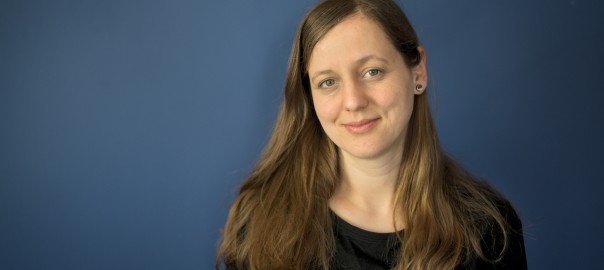A warm Darwin-welcome to Prof. Sinikka Lennartz who joins us for the coming year.
Sinikka Lennartz, is a marine biogeochemist interested in how the ocean interacts with the climate system on various timescales. Interactions between heterotrophic bacteria and dissolved organic matter are responsible for controlling a major reservoir of carbon in the ocean. During her time at MIT, using box models and the Darwin ecosystem model, Lennartz will focus on both to better understand the drivers of bacterial biogeography and their influence on dissolved organic matter turnover.
“I am always amazed by the sheer endlessness of the ocean, how it impacts our lives in so many ways – and how little we know about it. Ever since a student visit at Woods Hole Oceanographic Institution, and fieldwork as an ornithologist on a research vessel, I have wanted to be a marine scientist,” says Lennartz. “By identifying processes that shape the ecosystem of the sea and translating them into equations, I hope to increase our understanding of how the ocean is impacted by – and will impact us in – a changing climate.”
Lennartz, who moves to Cambridge with her husband and small daughter, did her undergraduate studies at the Universities of Tuebingen, Germany (Bachelor, 2010) and Braunschweig, Germany (Master, 2013) in Geoecology/ Environmental Sciences. She holds a PhD in Marine Biogeochemistry (2017) from the Geomar Helmholtz-Center for Ocean Research, Kiel, Germany. Following a short maternity leave, Lennartz began a postdoc at the Institute for Chemistry and Biology of the Marine Environment (ICBM) at the University of Oldenburg, Germany, where she has been using global-scale models to understand the long-term stability of dissolved organic matter in the ocean.
Although she is visiting under a German Research Association funded “Walter Benjamin Postdoctoral [One-year] Fellowship”, on April 1, Lennartz was appointed as a junior professor of biogeochemical ocean modeling at the University of Oldenburg where she will resume her position after her time at MIT.
Story image: When not unraveling the bacterial biogeochemistry of the ocean, Sinikka enjoys spending time outside, hiking, and particularly birdwatching (she is very excited to get to know the birds of North America!). For now, though, she says she is busy exploring the playgrounds of Cambridge with her little daughter.
Links
Website | Google Scholar | Researchgate
Recent Publications
Lennartz, S. T., Gauss, M., von Hobe, M., and Marandino, C. A. (2021), Monthly resolved modelled oceanic emissions of carbonyl sulfide and carbon disulfide for the period 2000–2019, Earth Syst. Sci. Data Discuss. [preprint], doi: 10.5194/essd-2020-389accepted, 2020.
Mentges A, Deutsch C, Feenders C, Lennartz ST, Blasius B and Dittmar T (2020), Microbial Physiology Governs the Oceanic Distribution of Dissolved Organic Carbon in a Scenario of Equal Degradability, Front. Mar. Sci., doi: 10.3389/fmars.2020.549784
Boyd, P., Lennartz, S., Glover, D. et al. (2015), Biological ramifications of climate-change-mediated oceanic multi-stressors, Nature Clim Change, doi: 10.1038/nclimate2441
